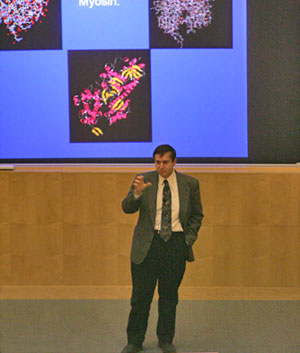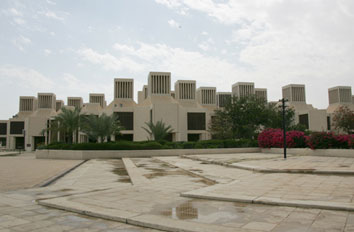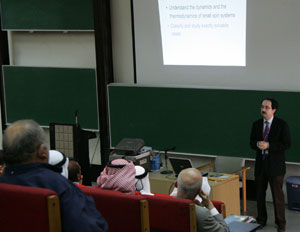Applying the science: physics, the biomedical sciences and translational research

Dr. Thorne: identifying protein structures by X-ray
crystallography may lead to new treatments for
diseases such as cancer.
Recently paying his third visit to Doha, Robert Thorne, Ph.D., professor of physics at Cornell University in Ithaca and course director for physics in the Pre–medical Program at WCMC–Q, worked through a busy schedule of meetings and lectures, and paid his first visit to Qatar University at the invitation of the physics faculty there.
There were opportunities to meet medical and pre–medical students at WCMC–Q; and to discuss with faculty and staff the development of new lab demonstrations, a project that began last summer as part of the collaboration between Cornell in Ithaca and its branch in Doha.
Interviewed during his stay, Dr. Thorne said that he would follow up a number of suggestions put forward by the medical students at WCMC–Q during their discussions, among them the inclusion in the physics course of more topics that are directly related to biomedical studies.
He noted that they were enthusiastic about the style of learning in the Medical Program, with its emphasis on problem–based learning (PBL) in small groups, and he had taken the opportunity to find out more: "They particularly mentioned that they like the style of the PBL sessions in the medical school. So I went to one to see how it worked. I was extremely impressed, partly because the students participated incredibly well and partly because the dynamic is so good."
Dr. Thorne also had high praise for the pre-medical class members he met: "They seem like another incredible bunch of students," he commented.
In two lectures to pre-medical students and faculty, Dr. Thorne looked at how principles studied in the physics 207 course may be applied in many different contexts in biology. In the first, he spoke about elastic mechanisms and springs in biology. In the second, on the physics of hearing, he explained the human auditory system and its "remarkable characteristics" including the ability to detect very small molecular motions and its enormous dynamic range.
Turning to the interrelation between research in physics and the biomedical sciences, particularly structural genomics, Dr. Thorne gave a seminar on how protein structures may be determined by X-ray crystallography, and the importance of this technique for the development of new treatments for diseases such as cancer.
"You need to understand how the proteins are structured before you can understand how they function, " he explained. "Once you have information about the structure, you can identify candidate drugs."
"An important way in which drug discovery happens now is that you solve the structure of a protein target — for example, a kinase involved in cell proliferation in cancer — and then you need to find a small molecule compound that will inhibit that kinase action, by attaching to the protein‘s active site and slowing the proliferation."
Work by Dr. Thorne‘s research group in this field has led to the development of a new technology to hold protein crystals securely when they are being examined by X-rays. After offering it to manufacturers, Dr. Thorne set up a new company in 2004, MiTEGen, to patent the technology.
The company now supplies over 20% of the world market. and the technology is used in the pharmaceutical industry and major laboratories, and by university research teams.
During his visit to Qatar University, Dr. Thorne met faculty members, toured the physics facilities, and gave a lecture entitled: "Collisions: from mass extinctions to the assassination of President Kennedy." The visit was arranged in the context of growing links between physics faculty at WCMC-Q and their counterparts at Qatar University; earlier in the semester, Dr. Marco Ameduri, senior lecturer in physics at WCMC-Q, also gave a talk at the University.

Qatar University, Doha, Qatar

Qatar University, Doha, Qatar
